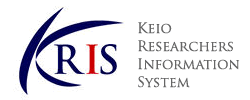-
Affiliation
-
Faculty of Pharmacy, Department of Pharmacy Division of Pharmacodynamics (Shiba-Kyoritsu)
-
Position
-
Research Associate/Assistant Professor/Instructor
-
E-mail Address
-


KEIO RESEARCHERS INFORMATION SYSTEM |
Details of a Researcher
このページはJavascriptを使用しています。すべての機能を使用するためにはJavascript を有効にする必要があります。
IGARASHI Yuki
|
|
|
Yokohama General Hospital, Pharmacy department, pharmacist
Keio University Faculty of Pharmacy, Division of Pharmacodynamics, Assistant Professor
Keio University, Faculty of Pharmacy, Pharmaceutical department
University, Graduated
Keio university graduate school
Graduate School, Graduated, Doctoral course
Ph.D. in Pharmaceutical Science, Keio university graduate school, Coursework, 2023.03
Komatsu T., Tomizawa A., Samura M., Suzuki A., Ishigo T., Fujii S., Ibe Y., Yoshida H., Tanaka H., Fujihara H., Yamaguchi F., Ebihara F., Maruyama T., Yagi Y., Hamada Y., Nagumo F., Takuma A., Chiba H., Nishi Y., Igarashi Y., Enoki Y., Otori K., Matsumoto K.
Journal of Infection and Chemotherapy 31 ( 12 ) 2025.12
ISSN 1341321X
Suzuki A., Fujihara H., Yamaguchi F., Yoshida H., Tanaka H., Yagi Y., Maruyama T., Hamada Y., Ishigo T., Fujii S., Nagumo F., Samura M., Chiba H., Ebihara F., Takuma A., Komatsu T., Tomizawa A., Nishi Y., Igarashi Y., Enoki Y., Matsumoto K.
Journal of Infection and Chemotherapy 31 ( 11 ) 2025.11
ISSN 1341321X
Ayano Kawasaki, Ryuya Shintani, Risa Takao, Yuka Nakazawa, Takayuki Mihara, Shintaro Ikegami, Sora Shimada, Yuri Matsumoto, Yuko Okamoto, Yuki Igarashi, Yuki Enoki, Kazuaki Taguchi, Kazuaki Matsumoto
Medical Mycology (Oxford University Press) 63 ( 10 ) 2025.09
Research paper (scientific journal), Joint Work, Corresponding author, Accepted, ISSN 13693786
Maiko Yoshikawa, Tomoyasu Nishimura, Kana Misawa, Rina Shimamura, Kenta Suzuki, Shoko Kashimura, Yuki Igarashi, Yuki Enoki , Kazuaki Taguchi, Naoki Hasegawa, Ho Namkoong, Kazuaki Matsumoto
Microbiology Spectrum 13 ( 11 ) e0201225 - 15 2025.09
Research paper (scientific journal), Joint Work, Accepted
Tomoyuki Ishigo, Ayako Suzuki, Yuta Ibe, Satoshi Fujii, Masahide Fukudo, Hiroaki Yoshida, Hiroaki Tanaka, Hisato Fujihara, Fumihiro Yamaguchi, Fumiya Ebihara, Takumi Maruyama, Yusuke Yagi, Yukihiro Hamada, Masaru Samura, Fumio Nagumo, Toshiaki Komatsu, Atsushi Tomizawa, Akitoshi Takuma, Hiroaki Chiba, Yoshifumi Nishi, Yuki Igarashi, Yuki Enoki, Kazuaki Matsumoto
Journal of Infection and Chemotherapy 31 ( 5 ) 2025.05
Accepted, ISSN 1341321X
炎症性腸疾患・Clostridioides difficile感染症マウスモデルを用いたfidaxomicinの有用性評価
三原 貴之, 五十嵐 裕貴, 榎木 裕紀, 田口 和明, 松元 一明
[Domestic presentation] 第72回日本化学療法学会東日本支部総会 第74回日本感染症学会東日本地方会学術集会 合同学会 ,
Oral presentation (general)
造血器腫瘍患者におけるバンコマイシン薬物動態モデル別の予測性の検討
坂本靖宜, 重村明香, 井出和男, 渡邉直優, 鈴木智代, 五十嵐裕貴, 榎木裕紀, 加藤英明, 松元一明
[Domestic presentation] 第72回日本化学療法学会東日本支部総会 第74回日本感染症学会東日本地方会学術集会 合同学会 ,
Oral presentation (general)
2点採血でバンコマイシンのAUCを算出した症例におけるAKIリスクの層別化
石郷友之, 鈴木絢子, 藤居賢, 伊部裕太, 吉田博昭, 田中宏明, 海老原文哉, 丸山拓実, 八木祐助, 佐村優, 南雲史雄, 小松敏彰, 冨澤淳, 詫間章俊, 千葉博暁, 五十嵐裕貴, 榎木裕紀, 浜田幸宏, 西圭史, 松元一明
[Domestic presentation] 第72回日本化学療法学会東日本支部総会 第74回日本感染症学会東日本地方会学術集会 合同学会 ,
Oral presentation (general)
Mycobacterium avium complexに対するβラクタム系抗菌薬2剤併用のin vitroにおける有効性評価
吉川万衣子, 西村知泰, 三澤可奈, 島村莉奈, 鈴木健太, 五十嵐裕貴, 榎木裕紀, 長谷川直樹, 南宮湖, 松元一明
[Domestic presentation] 第72回日本化学療法学会東日本支部総会 第74回日本感染症学会東日本地方会学術集会 合同学会 ,
Oral presentation (general)
Hollow Fiber Infection Modelを用いた肺MAC症に対する標準治療の有効性評価
鈴木健太, 島村莉奈, 吉川万衣子, 宇山杏奈, 林侑孝, 五十嵐裕貴, 榎木裕紀, 西村知泰, 松元一明
[Domestic presentation] 第72回日本化学療法学会東日本支部総会 第74回日本感染症学会東日本地方会学術集会 合同学会,
Oral presentation (general)
瞬間的MICとHFIMを用いた感染部位指向型PK/PD評価手法の構築
Japan Society for the Promotion of Science (JSPS), Grants-in-Aid for Scientific Research, Grant-in-Aid for Research Activity Start-up, Principal investigator
MA-T技術を活用した新規消毒剤の開発研究
OTC Self-Medication Promotion Foundation, 調査・研究助成, Principal investigator
第8回フレッシャーズ・カンファランス優秀演題発表賞
島村莉奈,西村知泰,吉川万衣子,三澤可奈,矢野大和,榎木裕紀,五十嵐裕貴,長谷川直樹,南宮湖,松元一明, 2025.06, 抗菌薬投与が引き起こすMycobacterium abscessusの細胞壁脂質とコロニー形態変化
Type of Award: Award from Japanese society, conference, symposium, etc.
日本化学療法学会Young Challenger Award(YCA)2025
五十嵐裕貴, 2025.05, 日本化学療法学会, β-ラクタム薬/β-ラクタマーゼ阻害薬の併用療法におけるin vivo pharmacokinetics/pharmacodynamics評価方法の構築
Type of Award: Award from Japanese society, conference, symposium, etc.
第34回日本医療薬学会年会Postdoctoral award
五十嵐裕貴, 2024.11, 日本医療薬学会, β-ラクタム薬/β-ラクタマーゼ阻害薬の併用療法におけるin vivo pharmacokinetics/pharmacodynamics評価方法の構築
Type of Award: Award from Japanese society, conference, symposium, etc.
2023年度KP会星野尚美記念薬学研究・活動奨励賞 研究論文部門
五十嵐裕貴, 2024, Development of an optimized and practical pharmacokinetics/pharmacodynamics analysis method for aztreonam/nacubactam against carbapenemase-producing K. pneumoniae
Type of Award: Other
Sato Pharmaceutical Research Encouragement Award
五十嵐裕貴, 2020, 佐藤製薬株式会社, PK/PD理論に基づくCefditorenの適正使用を目指したマウスにおける薬物動態研究
Type of Award: Other
SEMINAR (PHARMACODYNAMICS)
2025
RESEARCH FOR BACHELOR'S THESIS 1
2025
PRE-CLINICAL TRAINING FOR HOSPITAL & COMMUNITY PHARMACY
2025
PHARMACEUTICAL-ENGLISH SEMINAR
2025
ENGLISH EXERCISES FOR PHARMACEUTICAL SCIENCES
2025
The Japanese Society of Clinical Pharmacology and Therapeutics,
The Japanese Society of Pharmaceutical Health Care and Sciences,
Japanese Society of Chemotherapy,